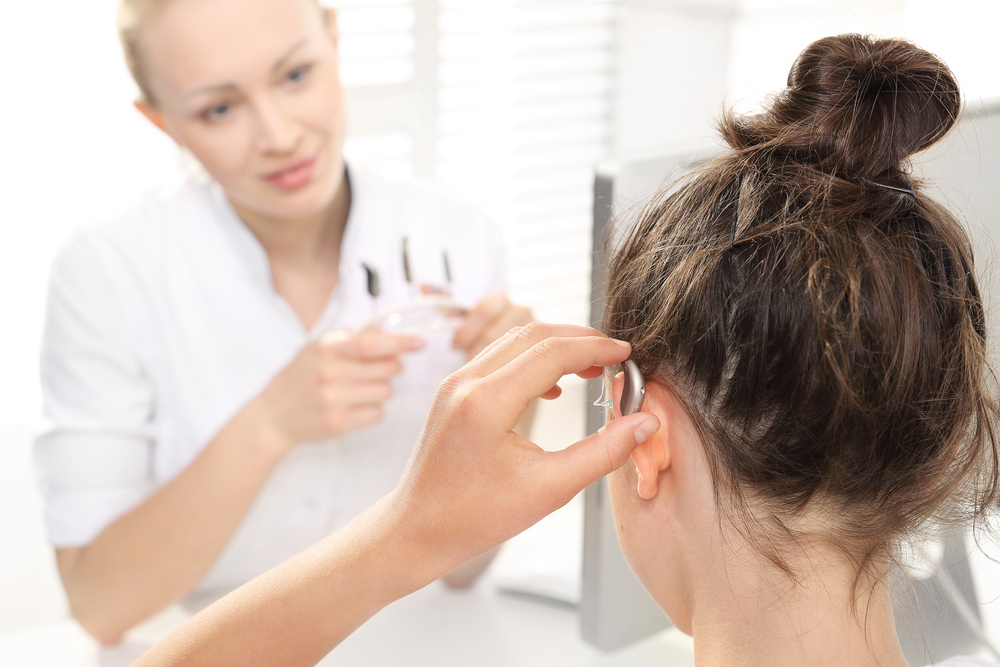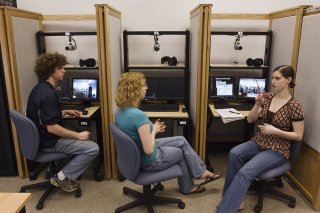
Robert Przybysz / Shutterstock.com
For students who are hard of hearing (HoH) or deaf, schooling has not always been easy. Depending on the severity of their hearing loss, their communication, language development, and learning can be hampered in an ill-equipped classroom. Some schools may not even realize how they’ve been wronging these students. Classmates talking during class, quick-speaking educators, and the direction the teacher is facing can all affect the success of a student with hearing loss.
When college students who are deaf or HoH pack up and move to college, they have to get used to much more than just the schoolwork. Finding teachers that understand and are sure to speak in their direction, meeting new friends that don’t shy away from communication barriers, and being separated from their support systems are additional challenges. Over time, though, with advances in technology, increased awareness, and rights guaranteed by the U.S. government, a college experience has become less daunting and more accessible to students with hearing loss.
In 1856, Amos Kendall, a postmaster general who served during two presidential administrations, made the first big step for students who were deaf and blind. He donated two acres of his own property in northeast Washington, D.C to accommodate the special schooling and housing needs of 12 lucky individuals who were deaf and blind. Later, he advocated that the school be incorporated by Congress and known as Columbia Institution of the Instruction of the Deaf and Dumb and Blind.

Students at the National Technical Institute for the Deaf (RIT NTID)
According to the university’s website, in 1864, Congress authorized this college to grant degrees. During the school’s first commencement in 1869, three graduates received diplomas. President Ulysses S. Grant signed each one, beginning a tradition that is still followed today: The sitting U.S. president signs every diploma conferred to the university’s graduates. Today, with more than 40 different majors for BA or BS degrees, this university is one of the most well known in the deaf community, but it goes by a different name: Gallaudet University.
Another college, well known for its efforts to provide students who are deaf and HoH with technical and professional education programs, is the National Technical Institute for the Deaf. In 1968, it opened its doors in Rochester, NY. Today, the school supports programs which educate the community, train interpreters, and prepare students for lifelong learning.
Of course, it’s great when colleges and government officials advocate for students, but it wasn’t until 1973 when the rights of those who are deaf and hard of hearing were truly recognized and protected. Section 504 of the Rehabilitation Act was created to prohibit discrimination on the basis of disability by institutions that receive federal funding. Furthermore, Title II of the Americans with Disabilities Act prohibits state and local government services (including public school districts) from discriminating on the basis of disability.
The two acts cover all the bases. The rights of students with disabilities are protected in virtually all settings because public school systems receive federal funds and public education is a government service. With this in mind, all schools must provide a free, appropriate public education for those with a disability.
Education reform initiatives have made further specifications to help students with disabilities, but their implementation varies among states, communities, and classrooms. Overall, these initiatives, laws, and advances in technology have made the classroom a less intimidating place for students with hearing loss.
How are lessons made available to students who are deaf and hard of hearing?
- Interpreters
- Captioning
- Procedural changes to accommodate the students (for example, providing them with a clear view of the board and allowing them to read the teacher’s lips)

Tobb8 / Shutterstock.com
- Assistive listening devices provided by the school
- Infrared Systems are used in large settings, like theaters or lecture halls, that have a TV set. Sound is transmitted from the TV through the infrared system using infrared light waves, which can be picked up by a receiver. An individual can then adjust the headphones to the preferred volume.
- Inductive Loop Systems allow hearing aid users to move freely, without needing to watch the teacher every second. With a loop system, the desired sound is brought directly to the student’s ear, without disruption of background noises.
- FM Systems have special microphones for teachers, which project their voices at a frequency that the listener’s receiver can pick up.
- Communication Action Real Time Translation (CART) is a device that instantly translates spoken word into text.
- Assistive listening devices provided by the student
- Hearing aids
- Cochlear implants
As awareness and understanding of the deaf and hard of hearing communities increase, classrooms become more welcoming. Other students volunteer to take notes so that their fellow classmates can focus on listening and reading their interpreters, and professors reserve seats at the front of the classroom.
Understanding one another does not require both individuals to hear; it requires both to be open.
-
Vocational Education from the 1900s to Today
-
The Reality of New York State’s Free College Education Bill
-
The TRIO Programs
-
The History of Historically Black Colleges and Universities
-
Environmental Education and Sustainable Schools
-
Co-Ed and Gender-Neutral Housing from the 1960s to Present
-
Distance Education through the Ages


